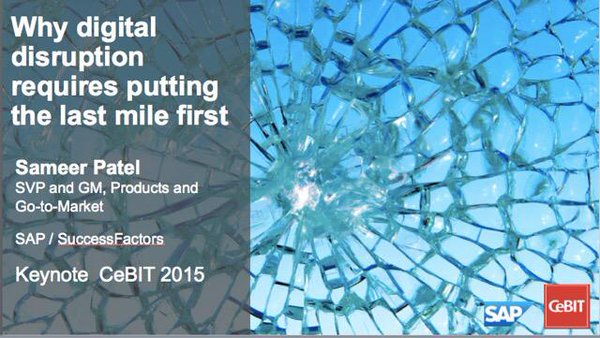What is the most important moment of truth shaping customer perception in a customer-facing operation or process? Is it when customers first get in touch with your business? Is it in the last mile of any transaction, service or logistics and the supply chain? Is it anywhere in-between or across all these occurrences?
One possible answer is that it all matters as the first touch, last mile and anything in-between the many experiences customers have across transactions, interactions and service moments constitute the business-critical end-to-end customer experience.
The key role of the last mile in digital transformation
A second possible answer is the last mile. And it’s as valid a response as the previous one. In fact, I believe it’s even what we should focus on most: we need to go the extra mile for the last mile.
Just consider what matters in the eyes of customer: it’s the perceived value of the end result, the outcome and the last impression that matters. Or as Sameer Patel (back at SAP) put it at CeBIT once: “Who owns the audience, owns the last mile. Closest to customer, closest to disruption“.
Below are a few questions and examples to illustrate this:
What is the use of having a great looking and intuitive application on a website to compare products and buy them in a highly engaging way when the delivery of the purchased goods is a total failure? Or worse: when the product turns out to be broken and next you get the most disappointing customer service ever?
What is the benefit of capturing customer data at the first point of contact with the promise of speeding up the process to treat a customer’s inquiry if the response to that request is slow, underwhelming and maybe even useless?
What do you remember when you went to a store on a great day with your best friends, enjoying an amazing shopping experience but then the cashier was extremely rude and essentially ruined the overall experience of what was until then a fun day out?
We all know many examples of the importance of the last mile, a term coming from the telecom industry. Customers care about the last mile and really don’t want to know what it takes for your business to deliver upon it.
The last mile is what customers remember
The connection of processes, information, service, divisions and actions as it relates to the customer – what digital transformation in a customer experience sense is really all about – is expected to simply work.
Obviously this doesn’t mean that all these other steps and the first touch don’t matter at all. If any step in the chain is broken, the last mile might be broken. In next blog post we’ll cover all those steps to make sure the flows and chains don’t break.
Essentially what we see here is the difference between digitization, automation and business process optimization on one hand and the core focus of digital transformation on the other: the last mile of customer experience.
Digital transformation needs an anchor to unify the organization and that anchor is the dynamic and digital customer (Charlene Li)
Data, automation and process in function of customer value
The essence of putting digital at work in a ‘transformative’ way is making sure that data and information flow into automated process, connecting divisions, back office and front office, to enhance customer experience or, more generally, stakeholder experience and thus add value and connect around the customer.
Let’s take the example of the shopping process that I mentioned earlier and look at a non-exhaustive list of some steps.
- Information enters the business, including behavioral data, customer details, product information and payment details.
- It all needs to be processed and set processes in motion. We automate as much of these processes as possible. Even in the more ‘physical aspects’ of the actual delivery and potential service moment, digitized information and underlying automated processes are key.
- The customer wants to be notified when delivery will happen and control it. When the driver leaves a text message or notification should be sent so the customer doesn’t have to waste time sitting at home all day before the products are delivered.
- The driver needs the customer data. They need a proof of delivery that is digitized and sets other processes in motion.
- Customer service needs to have access to all details about the delivery and potential follow-up. Invoices need to be sent.
…and the list goes on.
Using information to understand and exceed customer expectations is THE competitive advantage today (John Mancini)
Customer experience as the orientation point for digital transformation
Digital transformation consists of a long list of processes, interconnections and optimizations. And it is hard but there is little choice.
As Charlene Li once put it in an interview: “What’s the purpose and the reason of going through this painful process (of digital transformation)? We realized it had to be centered around this very dynamic digital customer”. The customer and customer experience indeed.
Most digital transformation initiatives today de facto revolve around (the) customer experience, even if it’s at least as much about costs and control as the customer as such.
And, as it happens, Accenture (re)confirmed this assessment with a report “Digital Transformation in the Age of the Customer”. The data, statements and infographic in the press release are clear. Here are just two:
- Customer experience is at the heart of digital and digital is likewise at the heart of customer experience.
- “Improving the customer experience” topped the list of business priorities companies have for the next 12 months. It received the most number one rankings (21 percent), followed by “growing revenues” (17 percent) and “improving differentiation” (16 percent).
In customer experience, the first touch doesn’t mean a thing when we don’t make the last mile of business smarter and more customer-focused. The ways to get there are full of obstacles, not just in the front end but across the full supply chain and in the back office. On top of the hurdles which Accenture emphasizes in its latest research and is often stressed by others such as leadership and cross-divisional collaboration, the challenges in getting that last mile right is clearly about information at the right time and place and about the (control over) supply chains.
Who owns the audience, owns the last mile. Closest to customer, closest to disruption (Sameer Patel)
Connecting the dots across the value chain to make a lasting impression
However, as said and to conclude, the last mile can’t be excellent if all the other touches and processes they set in motion are not properly functioning.
- It starts with capturing the right information, whereby we want to capture as close as possible to the process, line of business application, point of origin and customer (not a coincidence). Data accuracy plays an essential role here.
- We want to get the information into the right processes as fast, accurate and qualitative as possible. Speed is a keyword here because it is for the – impatient – customer. Speed is a competitive advantage in this real-time economy.
- We need to make sure the information silos and divisional disconnects are joined up in function of the last mile, the outcome, using intelligent information management and all the technologies that help improve the ultimate customer perception across all contact moments.
- It requires investing in knowledge management in customer service with knowledge being essential for the last mile in many cases. It’s where we close the gaps between the back office and the front office.
You know what they say about first impressions: you will never get a second chance to make one. A truism for sure. But here are two other sayings to ponder: “Almost everyone will make a good first impression but only a few will make a good lasting impression” and “A bad dessert can ruin the meal”.

How often do we see that first impressions in human relations don’t last and we change our perception of people over time as we get to know them, often seeing we were wrong? Being wrong in business can be fatal and that change is what digital transformation is about.


